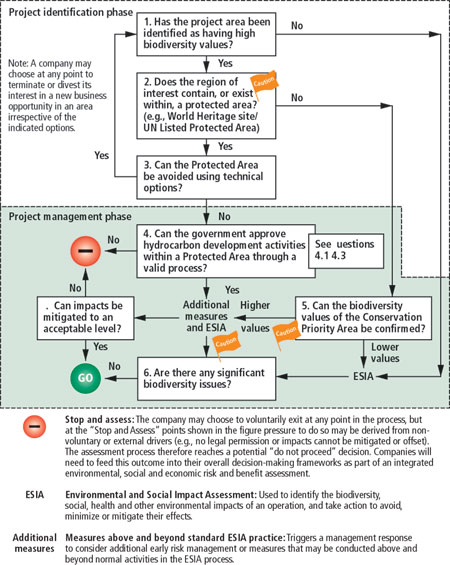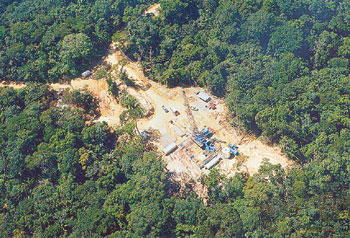Protecting the Environment
The Energy and Biodiversity Initiative can make a difference in operating practices
The EBI is an unlikely consortium of energy companies and environmental organizations, but new attitudes find common ground to find specific solutions to minimize upstream E&P impact
Perry A. Fischer, Editor
Biodiversity is fundamental to human welfare and economic development. The Energy and Biodiversity Initiative (EBI) resulted from the need for energy companies to plan and formalize best E&P practices in areas recognized for their rich biodiversity. After more than a year of discussion with Conservation International and others, 10 companies and organizations met in January 2001 to map out a work plan with some specifics. Four working groups were established: The Business Case, Biodiversity Conservation Practices, Site Selection, and Indicators.
After two years of quarterly meetings and several public feedback forums including oil and gas industry conferences, initial products were finalized in August 2003. The participating organizations are: The Center for Environmental Leadership in Business, Conservation International, Flora and Fauna International, IUCN – The World Conservation Union, The Nature Conservancy, Smithsonian Institute, BP, ChevronTexaco, Shell and Statoil.
RESULTS THUS FAR
Initial products covering nine topics were recently completed and are available through the EBI website. The topics are:
- Integrating Biodiversity into Environmental and Social Impact Assessment Processes
- Framework for Integrating Biodiversity into the Site Selection Process
- Good Practice in the Prevention and Mitigation of Primary and Secondary Biodiversity Impacts
- Opportunities for Benefiting Biodiversity Conservation
- Negative Secondary Impacts from Oil and Gas Development
- Integrating Biodiversity into Environmental Management Systems
- Integrating Biodiversity Conservation into Oil & Gas Development
- Biodiversity Indicators for Monitoring Impacts and Conservation Actions
- Online Biodiversity Information Resources
- International Conventions.
These topics comprise nearly 300 pages of documents. In the chapter, Building the Business Case, three issues are identified as key:
- Limit project delays and build relationships with local stakeholders.
- Establish a positive reputation as a responsible operator.
- Become the company of choice for governments, investors and partners, and other stakeholders.
Failure to accomplish these basic goals can result in project delays, unexpected costs, and conflicts with government agencies and communities. A company also runs the risk of creating a negative reputation as an irresponsible operator, with long-term constraints on future business, including access to capital and acreage available for exploitation.
Most of the documents use a question and answer style to direct workflow. Often, workflow is illustrated with a flowchart, Fig. 1. There is even a hypothetical case study at the end of Biodiversity Indicators for Monitoring Impacts and Conservation.
 |
Fig. 1. A typical flowchart for determining site selection.
|
|
Negative Secondary Impacts deals with the law of unintended consequences. Often, identifying an area with high biodiversity is straightforward, almost easy. Mitigating the immediate effects of development is also becoming more established every day. It’s the unforeseen, long-term effects that get companies in trouble with local communities. For example, the accidental introduction of foreign diseases, non-native plants and animals can have a devastating long-term effect on plant, human and animal communities.
Roads create easy access to areas previously remote and, in many ways, protected by that remoteness, Fig. 2. Quick and easy timber harvesting, slash and burn agriculture, poaching and other, non-sustainable activities often follow the roads. Oil and gas companies often do not have direct control of secondary impacts, which makes it all the more important to begin planning early, working with local and state governments and communities to minimize the long-term negative effects of oil and gas extraction.
 |
Fig. 2. Roads to previously inaccessible regions can have serious, long-term negative impacts.
|
|
THE ROAD AHEAD
It should be remembered that EBI is not a governmental organization; it has no enforcement teeth. The laws of each country and specific contract terms dominate minimum environmental requirements. Members, as well as other users, are free to integrate EBI practices to whatever extent their company chooses. However, the products and recommended practices of the EBI conform to the International Standards Organization ISO 14001 requirements.
From here, EBI will coordinate with the wider oil and gas industry and environmental community. EBI will seek to promote, test and refine the use of EBI products, working closely with the Biodiversity Working Group, jointly established by the International Petroleum Industry Environmental Conservation Association (IPIECA) and the International Association of Oil and Gas Producers (OGP). In addition, EBI will participate in the IUCN-convened Working Group on Extractive Industries.
More information can be found at: http://theebi.org. 
|




